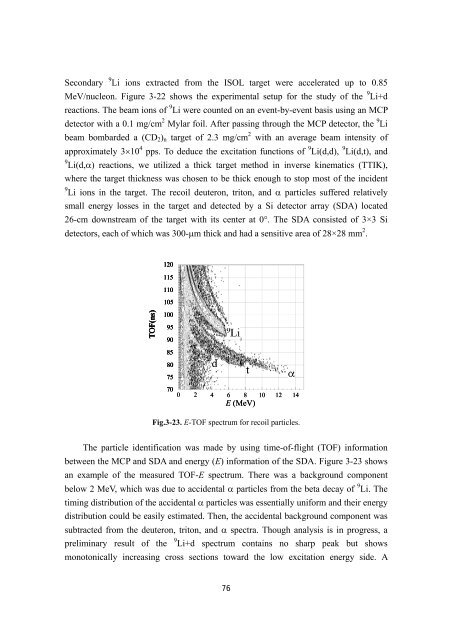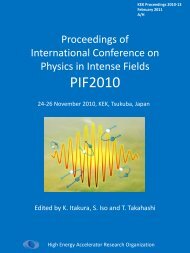TRIAC Progress Report - KEK
TRIAC Progress Report - KEK
TRIAC Progress Report - KEK
Create successful ePaper yourself
Turn your PDF publications into a flip-book with our unique Google optimized e-Paper software.
Secondary 9 Li ions extracted from the ISOL target were accelerated up to 0.85<br />
MeV/nucleon. Figure 3-22 shows the experimental setup for the study of the 9 Li+d<br />
reactions. The beam ions of 9 Li were counted on an event-by-event basis using an MCP<br />
detector with a 0.1 mg/cm 2 Mylar foil. After passing through the MCP detector, the 9 Li<br />
beam bombarded a (CD2)n target of 2.3 mg/cm 2 with an average beam intensity of<br />
approximately 3×10 4 pps. To deduce the excitation functions of 9 Li(d,d), 9 Li(d,t), and<br />
9<br />
Li(d,α) reactions, we utilized a thick target method in inverse kinematics (TTIK),<br />
where the target thickness was chosen to be thick enough to stop most of the incident<br />
9<br />
Li ions in the target. The recoil deuteron, triton, and α particles suffered relatively<br />
small energy losses in the target and detected by a Si detector array (SDA) located<br />
26-cm downstream of the target with its center at 0°. The SDA consisted of 3×3 Si<br />
detectors, each of which was 300-µm thick and had a sensitive area of 28×28 mm 2 .<br />
TOF(ns)<br />
120<br />
115<br />
110 110<br />
105<br />
100<br />
95<br />
90<br />
85<br />
80<br />
75<br />
70<br />
0 2 4 6 8 10 12 14<br />
E (MeV)<br />
Fig.3-23. E-TOF spectrum for recoil particles.<br />
The particle identification was made by using time-of-flight (TOF) information<br />
between the MCP and SDA and energy (E) information of the SDA. Figure 3-23 shows<br />
an example of the measured TOF-E spectrum. There was a background component<br />
below 2 MeV, which was due to accidental α particles from the beta decay of 9 Li. The<br />
timing distribution of the accidental α particles was essentially uniform and their energy<br />
distribution could be easily estimated. Then, the accidental background component was<br />
subtracted from the deuteron, triton, and α spectra. Though analysis is in progress, a<br />
preliminary result of the 9 Li+d spectrum contains no sharp peak but shows<br />
monotonically increasing cross sections toward the low excitation energy side. A<br />
76













